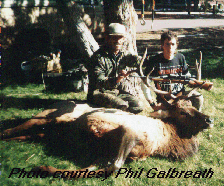|
One of the most magnificent mammals of North America, elk, or "wapiti,"
roam in herds through the pine forests of northern Arizona
mountains. The mating call, or bugling, of bull elk in the early
fall is a sound, once heard, is never forgotten.
 Description: One of the largest
Arizona mammals (second only to bison), elk have a tawny brown body
with a cream-colored rump patch and dark brown neck and head. Bull
elk can reach approximately 4-5 feet in height at the shoulder and
can weigh up to 1,000 pounds. Female elk (cows) are generally
smaller, do not grow antlers, and as adults, weigh approximately
500 pounds. Description: One of the largest
Arizona mammals (second only to bison), elk have a tawny brown body
with a cream-colored rump patch and dark brown neck and head. Bull
elk can reach approximately 4-5 feet in height at the shoulder and
can weigh up to 1,000 pounds. Female elk (cows) are generally
smaller, do not grow antlers, and as adults, weigh approximately
500 pounds.
Habitat: Elk prefer pine and mixed
conifer forests with interspersed meadows in the summer, and open
foothills and pinyon-juniper areas in winter.
Food
Preferences: A grazing animal, elk feed on grasses, sedges, and
new tree growth (particularly aspens and willows) as well as shrubs
and weeds.
Breeding notes: Normal breeding period
is September-October, with bugling starting in late August. Calves
are born in May or June. The average cow elk gives birth to one
calf. Bull elk guard their "harem" of cows during the breeding
season, often showing displays of aggression to other bulls who
attempt to attract a cow from its harem.
Predators or Enemies: Mountain Lion and Coyote
Size Individual Range: 20-30 square miles
Distribution: 6,000-10,000 in Northern Arizona
Hunting hints: It's best to scout prior to hunting
season. Scouting is most successful in the early morning and late
evening. Look for signs of tracks and scat. A U.S. Forest Service
Apache-Sitgreaves National Forests map is essential. Use binoculars
to glass a large area from a high point.
 Information courtesy Arizona Game & Fish
Department, Region 1-Pinetop,AZ Information courtesy Arizona Game & Fish
Department, Region 1-Pinetop,AZ
|

 Information courtesy Arizona Game & Fish
Department, Region 1-Pinetop,AZ
Information courtesy Arizona Game & Fish
Department, Region 1-Pinetop,AZ